Arm Unveils 2023 Mobile CPU Core Designs: Cortex-X4, A720, and A520 - the Armv9.2 Family
by Gavin Bonshor on May 28, 2023 8:30 PM ESTCortex-A720: Middle Core, Big on Efficiency
Focusing on Arm's latest middle core, the Cortex-A720 hasn't changed much from the previous Cortex A715 design last year, which was also Arm's first AArch64-only middle core. Arm has a set philosophy for its A700 family, and that's mostly about increasing performance through optimizations, delivering maximum levels of power efficiency within set thermal limits, and optimizing workloads for actual use cases instead of blisteringly fast benchmark performance. Arm's key aims are to enhance performance metrics while maintaining power efficiency, area, and all within an acceptable thermal envelope. Cost is also essential, with many entry-level mobile devices already on the market leveraging the Cortex A700 family for its main cores.
Similar to the Cortex-X4 in that the Cortex-A720 is built around the Armv9.2 ISA, Arm has optimized its design to enable the A720 to deliver more performance within the same power budget compared to the Cortex A715. The Arm 700-series family typically covers a much broader range of applications and caters to various markets, including, and not limited to, digital TVs (DTV), smartphones, and laptops. Having more comprehensive flexibility in a more diverse space has its advantages, and Arm looks to capitalize on that with the Cortex-A720 acting as the 'workhorse' of the TSC23 core cluster.
Devices such as smartphones at the entry-level typically want to reduce cost but maximize performance and efficiency, and that's where cores such as the Cortex-A720 come into play; the Cortex-X4 is primarily allocated to devices with flagship status or those that require the most burst and sustained performance, such as top tier smartphones, tablets, and laptops. Meanwhile, Cortex-A720 is the next step down, giving up the X4's high peak performance for a much smaller core size and with correspondingly lower energy consumption.
For the Cortex-A720 in particular, Arm is also offering multiple configuration options. Along with the standard, highest-performing option, Arm has what they're terming an "entry-tier" configuration that shaves A720 down to the same size as Arm Cortex-A78, all while still offering a 10% uplift in overall performance. With some Arm customers being especially austere on die sizes, moves such as these are necessary to convince them to finally make the jump over to the Cortex-A7xx series and Armv9.
Arm's focus is to broaden the range of the entry-level market and expand on the possible use cases for its Cortex-A720 core so that it can be implemented into a wider variety of entry-level mobile devices and in lower-end markets.
Some of the critical improvements to the Cortex-A720, when compared to the previous A715, is Arm has opted for a faster branch mispredict recovery. Branch prediction breaks down the instructions into predicates, and a branch predictor will only execute statements it predicates to be true. Opting for a faster branch mispredict recovery has multiple benefits, as it not only reduces the delay within the execution of instructions, but it can improve overall performance. Another element of this is pipeline efficiency, as a branch misprediction can disrupt the flow of instruction throughout the pipeline, and the ability to do this faster not only yields benefits to performance but also to overall power efficiency.
Arm has reduced the overall branch mispredict penalty on A720 to 11 cycles, down from 12 on the Cortex A715. They have also improved upon their 2-taken branch prediction technique, which predicts the outcome of the instruction, and, again, adds efficiency to the pipeline and reduces the penalties regarding misprediction.
Another improvement is the Pipelined FDIV/FSQRT (division + square root), which performs operations on floating point numbers using the pipelines. Allowing for concurrent executions of both FDI and FSQRT can improve instruction throughput, and Arm claims to have achieved a significant speed boost without impacting the overall area. There are also faster transfers from floating point to floating point, including NEON and SVE2 integer, which Arm introduced for Armv9. This also includes overall improvements to issue queues and the execution units, which simplifies the forwarding of data forwarding to AGUs.
Within the memory system of the Cortex-A720, reduced the L2 cache latency to 9-cycles, and Arm claims to have up to 2x the memset(0) bandwidth within the L2 cache. Without going into much detail about their methods, Arm also claims to have improved generationally on accuracy and coverage to the prefetcher. However, it has a new L2 spatial prefetch engine, which was previously a pioneering Cortex-X core system design feature.
Translating the refinements and improvements to performance, Arm estimates the performance uplift to be about 15% at iso-frequency, depending on the workload. Among other benchmarkmarks, thare are clear gains over the previous generation in SPECint2017 and improvements within internal testing with SPECint2006. For example, using SPECint2007 as its performance indication metric in SPECint2007_403.gcc, the Cortex-A720 has a gain of around 5% over the Cortex A715, with an even more significant improvement of about 6% in power efficiency.
Other performance metrics on offer include DRAM reads, which Arm has focused a lot of attention on making more efficient, showing minor gains overall; SPEC2007int_483.xalacbmk shows a massive increase of up to 41% in DRAM read performance. While everything is relative and subjective to the workload tasked, Arm has made some clear forward progress with its latest Cortex-A720 CPU core microarchitecture.


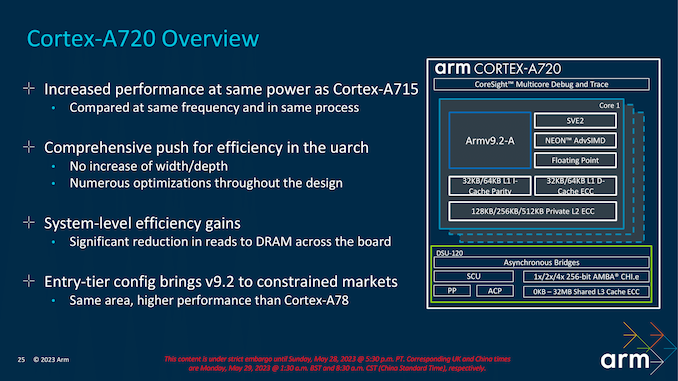
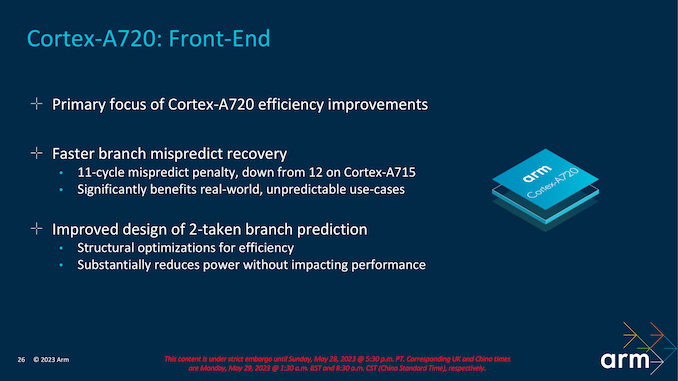
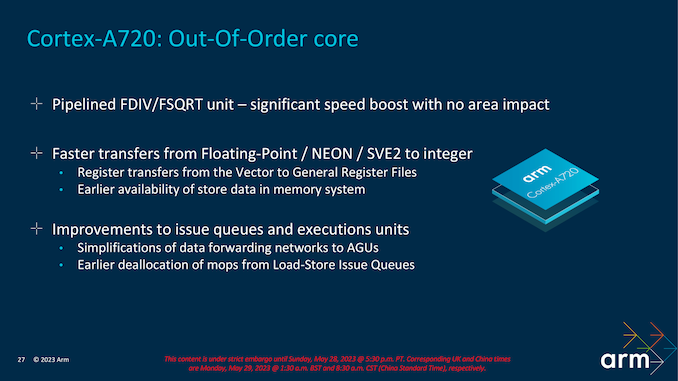
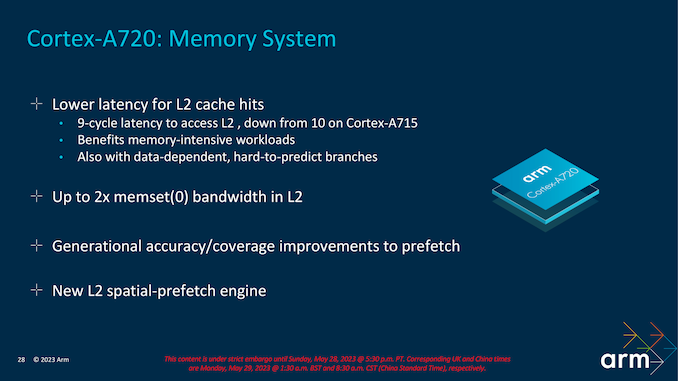
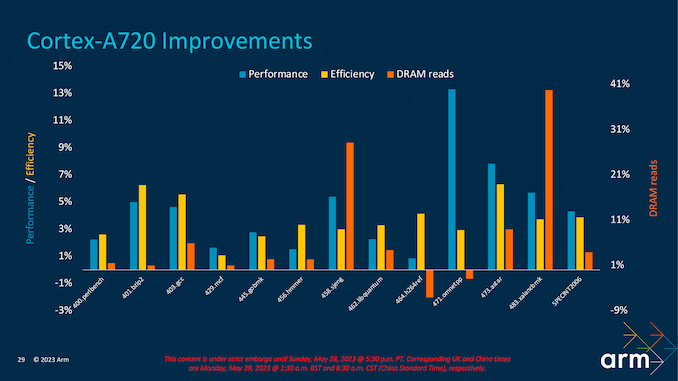








52 Comments
View All Comments
Ryan Smith - Monday, May 29, 2023 - link
Thanks!GC2:CS - Tuesday, May 30, 2023 - link
Mediatek dimensity 93004xx4 + 4x A720 no little cores. 50% lower power, beats next gen Apple CPU (A17).
First time one ever with more than 3 X CPU’s ?
https://m.gsmarena.com/mediatek_dimensity_9300_tip...
iphonebestgamephone - Tuesday, May 30, 2023 - link
8cx gen 3 - 4x x1 + 4x a78tipoo - Thursday, June 1, 2023 - link
Given that A17 isn't out yet, how do we know?Zoolook - Sunday, June 4, 2023 - link
4 X4s would make for a very big chip, I doubt it, but we'll see, A17 is on N3 and Dimensity 9300 will be on N4P so also doubt that.NextGen_Gamer - Tuesday, May 30, 2023 - link
Is there going to be another follow-up article about the new Immortalis-G720 GPU?brucethemoose - Tuesday, May 30, 2023 - link
^I think the GPU is becoming the more critical part in phones... I hate to downplay CPU advances, but what does being faster than an X1 really get you on mobile these days?
GPUs, on the other hand, are the bottleneck for running local AI. Flagships can already run 7B LLMs and other generative models reasonably well, but every ounce of extra GPU speed allows for significantly better inference. They are also the bottleneck for VR/AR and ports of PC/console games.
nandnandnand - Tuesday, May 30, 2023 - link
The real advance for CPU might be locking the performance in place but lowering the power usage. Which is why we're hearing about Dimensity 9300 supposedly packing four Cortex-X4 cores and four Cortex-A720 cores, with no presence of Cortex-A520. In a smartphone SoC.Shouldn't these flagships being using their dedicated AI accelerators instead of the GPU for inference?
TheinsanegamerN - Wednesday, May 31, 2023 - link
AI accelerators are just that, accelerators. You still need heavy compute power, and that comes from GPUs.nandnandnand - Wednesday, May 31, 2023 - link
I don't think an iGPU is significantly more powerful than an AI accelerator.